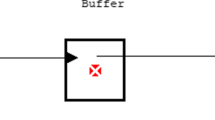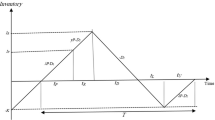Abstract
Consider a flexible assembly cell, consisting of a set of general-purpose machines, a finite-capacity local storage, a loading station, an unloading station and an integrated automated inspection station, where workpieces are processed according to the first-come, first-served dispatching rule, and the inspection station is capable of detecting (i) non- repairable defective, (ii) repairable defective and (iii) non-defective workpieces. This workstation is capable of processing workpieces belonging to the same family of parts, and is also capable of reprocessing the inspected defective repairable workpieces. In this paper, the performance of the workstation is modelled by anM/G/1/K queueing system with a Poisson arrival process, a buffer of sizeK, a single server, generally distributed processing time, the first-come, first-served queueing discipline and an instantaneous Bernoulli feedback mechanism. This performance model is developed to define the relationships among the loading, the processing, the inspection and the unloading operations. Finally, to be able to study the tandem behaviour of this workstation in an assembly-line manufacturing environment, the throughput process from the workstation is also identified.
Similar content being viewed by others
References
D. J. Daley and D. N. Shanbhag, (1975), “Independent inter-departure times inM/G/1/N queues”,Journal of the Royal Statistical Society, Series B,37, pp. 259–263, 1975.
R. L. Disney and P. C. Kiessler,Traffic Processes in Queueing Networks: A Markov Renewal Approach, John Hopkins University Press, Baltimore, 1987.
P. J. Kuehn, “Approximate analysis of general queueing networks by decomposition”,IEEE Transactions on Communications,COMM-27(1), pp. 113–126, 1979.
W. Whitt, “The queueing network analyzer”,Bell System Technical Journal,62(9), part 1, pp. 2779–2815, 1983.
B. Pourbabai, “An assembly cell with an automated quality control station: generally distributed processing times”,International Journal of Robotics and Computer-Integrated Manufacturing,6(2), pp. 117–123, 1989.
B. Pourbabai, “An assembly cell with an automated quality control station: a finite capacity and generally distributed processing times”,International Journal of Computers and Mathematics,18(4), pp. 321–328, 1989.
P. H. Waghodekar and S. Sahu, “Group technology: a research bibliography”,Research,20(4), pp. 225–249, 1983.
A. V. Feigenbaum,Total Quality Control, 3rd Edn, McGraw-Hill, New York, 1983.
D. Gross and C. M. Harris,Fundamentals of Queueing Theory, Wiley, New York, 1975.
R. L. Disney, D. Konig and V. Schmidt, “Stationary queue length and waiting time distributions in single server feedback queues”,Advances in Applied Probability,16, pp. 437–446, 1984.
N. M. Akulinichev and V. A. Ivannikov, “Distribution of the characteristics of a stream of lost calls”,Izv. Akad. Nauk SSSR, Tech Kibernetika,4, pp. 85–90 (Engl. transl. “Distribution of lost calls”,Engineering Cybernetics,4, pp. 695–700, 1970).
Author information
Authors and Affiliations
Rights and permissions
About this article
Cite this article
Pourbabai, B. Effect of reworking on defective parts in a flexible assembly cell. Int J Adv Manuf Technol 8, 96–101 (1993). https://doi.org/10.1007/BF01748774
Accepted:
Issue Date:
DOI: https://doi.org/10.1007/BF01748774




